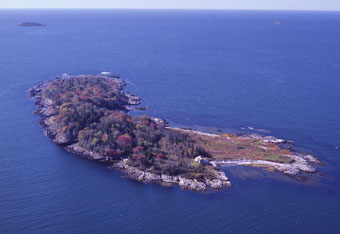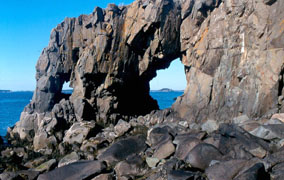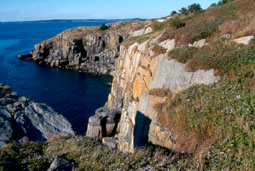
![]()
Volume 7, No. 1
Promoting Cooperation to Maintain and Enhance
Environmental Quality in the Gulf of Maine
|
||||||||||
|
|
|
|
|
|
|||||||
|
|
|
|
Browse the archive |
|
|
|
|
Partnerships ensure protection for Maine lands
Maine Coast Heritage Trust’s distinct approach has conserved 260 coastal islands
By Lee Bumsted
On a sunny day last fall, I drove down the Phippsburg Peninsula in southern Maine until I reached a convenient launch ramp. I had two sea kayaks strapped on top of my car, so that Chris Hamilton of the Maine Coast Heritage Trust (MCHT) could join me. We readied our gear and then paddled a short distance offshore to Malaga Island, one of the trust’s recent acquisitions. When we landed on a pocket beach at the north end of the 41-acre island, I could see why Hamilton had packed his camera. Rounded wooden lobster traps, abandoned in favor of the more durable rectangular wire models, littered the shore and sumac was taking on its autumn colors. From our lunch perch atop a stretch of granite ledge, we had a fine view of neighboring islands and passing fishing boats.
 |
| Twenty-six acre Flag Island in Casco Bay, owned by the Maine Department of Inland Fisheries and Wildlife is home to one of the largest eider duck nesting colonies in the state. The island's purchase was made possible through the Maine Coast Heritage Trust. |
as we can.” What he hopes to protect them from is new construction, such as the large glass-fronted vacation homes and “kingdom estates” that have been cropping up along the Maine coast.
Maine Coast Heritage Trust has been quietly operating since 1970. The statewide trust holds as its mission “to conserve coastal and other lands that define Maine’s distinct landscape, protect its environment, sustain its outdoor traditions and promote the well-being of its people.” It does this through extensive partnering with federal agencies, state agencies and local land trusts, in addition to working with the landowners themselves. Private philanthropy, endowment income and grants fund its annual operations budget of approximately $2.25 million. The trust has helped conserve an impressive 112,000 acres, including 260 entire coastal islands.
Unlike most land trusts, Maine Coast Heritage Trust generally does not hold onto the properties it works so hard to acquire. Of the 850 land protection deals it has completed, the trust only owns 48 properties outright. It holds conservation easements, which place limits on future development, on 95 others. It has transferred the remaining properties and easements to its partners.
One of its partners, the U.S. Fish and Wildlife Service (USFWS), identifies important habitats for migratory and endangered fish and wildlife. The trust works with the owners of these areas to determine if there is an opportunity to protect that habitat. If there is, the trust takes a lead role in acquiring the land on behalf of either USFWS or the Maine Department of Inland Fisheries and Wildlife.
Collaboration is key
Maine Coast Heritage Trust has the staffing and financial resources to acquire land quickly when an opportunity arises. For example, Jordan’s Delight, a 27-acre island near Milbridge that provides significant nesting habitat for guillemots, eiders and storm petrels, came on the market in 2000 for $1.6 million. A 3000-square-foot house was under construction and nearly completed. MCHT’s staff was able to find a family foundation to purchase the island and then donate 90 percent of the island to the trust. The foundation did have one condition: the trust had to pay for removal the house. So the trust spent $100,000 for the house removal plus some legal expenses. It will transfer the land to USFWS as soon as the agency is able to reimburse the trust that amount.

|
| The Maine Coast Heritage Trust and the U.S. Fish and Wildlife Service have worked together to acquire Jordan’s Delight, a 27-acre island near Milbridge that provides significant nesting habitat for guillemots, eiders and storm petrels. Photos courtesy of the Maine Coast Heritage Trust |
Twenty-six acre Flag Island had previously been identified by USFWS and the Maine Department of Inland Fisheries and Wildlife as home to one of the largest eider duck nesting colonies in the state, and the largest in Casco Bay. When Flag came on the market, MCHT used funds from its Campaign for the Coast, a five-year, $100 million fundraising effort, to quickly purchase it before it could become a “kingdom estate.” This gave the Maine Department of Inland Fisheries and Wildlife the two years it needed to seek and obtain five federal and state grants so it could then purchase the island at the trust’s cost.
While Flag Island has been set aside for bird habitat, traditional uses of Malaga will continue thanks to Magala’s previous owner who sold the island to the trust for the same price he paid for it many years before. Local fishermen will still be able to store their lobster traps on the island in winter, and take their families there for Fourth of July picnics. Low-impact recreational access to mile-long Whaleboat has also been assured.
Stewart Fefer, project leader for the USFWS Gulf of Maine Program, sees many benefits to partnerships with MCHT. He notes that the trust can work with landowners to understand their needs and advise them of the tax advantages of conservation options such as easements and selling their property below its fair market value. The trust can make immediate purchases of land, allowing its partners time to raise the necessary funds. In addition, the trust is not constrained by the requirement to offer the appraised fair market value for land, as a federal agency is. Fefer says, “Maine Coast Heritage Trust brings many skills and resources to the table in partnerships with landowners, non-government organizations and government agencies that allow significant coastal land protection projects to occur that would not happen otherwise.”
Programs assist local land trusts
In addition to teaming with state and federal agencies, Maine Coast Heritage Trust often assists local land trusts, many of which it helped start back in the 1980s. Some of the 90 local land trusts in the state have staff members, but many are all-volunteer operations. MCHT lends its technical and legal expertise, as well as financing from its Revolving Loan Fund, to these local land trusts to increase their effectiveness. It coordinates the Maine Land Trust Network, which is designed to enhance communication among the various Maine land trusts. MCHT recently created a Conservation Easement Registry, a voluntary program for easement holders. The program acts as a sort of insurance policy, permitting the tracking of easements so none are forgotten. It will facilitate the reassignment of an easement if necessary, so that the land remains protected.
Unlike organizations that have narrow criteria for land acquisition, Maine Coast Heritage Trust values a broad range of conservation attributes. It examines scenic, ecological, recreational and cultural values, as well as productive traditional uses such as fishing and farming, when considering a land purchase. In addition to keeping an eye on real estate listings, the trust is also proactive. It is in contact with island owners all along the coast and focuses projects on “whole places,” special places that function as a unit but are held by many landowners. Its protection of stretches of Maine’s spectacular Bold Coast near the Canadian border is an example of this latter approach.
Hamilton says that there is a push on at MCHT to step up its land acquisition efforts because of a trend for people to build “glass palace” retirement or vacation homes, either in place of older, smaller homes or on previously undeveloped coastal land. “It’s 10 years before the baby boomers retire, with their unprecedented expendable wealth and very expensive homes in urban areas,” says Hamilton. He sees a closing window of opportunity for land conservation because of the extra demand these new retirees could place on coastal Maine, where waterfront property is more available and affordable than it is to the south.
In the past, MCHT went about its work so quietly that many Maine residents and visitors were unaware of its existence. Two years ago the trust decided to seek greater visibility. It hopes to attract more donations of easements, land and money. It also hopes increased visibility will lend more support to its public policy initiatives. Hamilton says that part of conserving a property is looking at long-term threats to it, and taking concerns to the state legislature if need be. For instance, Hamilton notes that MCHT is generally supportive of aquaculture. However, it has concerns about proposals for five large finfish aquaculture facilities, complete with feed barges, generators and lights. These facilities would all be adjacent to islands the trust conserved. MCHT plans to put together evaluation criteria to help assess the impacts of aquaculture on neighboring shores and waters.
As we prepared to paddle from Malaga Island back to the mainland, Hamilton commented that Maine Coast Heritage Trust protects land “so that the character of Maine will stay, and that the coast we all know and enjoy now will be there for future generations as well.” MCHT’s extensive partnering with other organizations focused on coastal protection bodes well for that treasured character.
For more information about Maine Coast Heritage Trust, land conservation, and Maine land trusts, visit www.mcht.org or phone (207) 729-7366.
